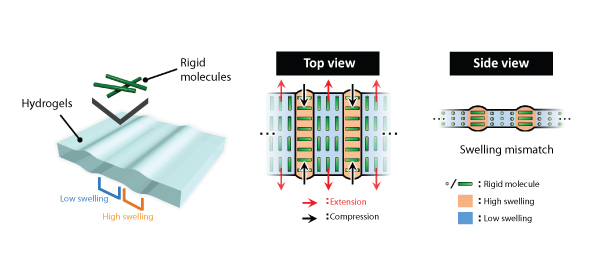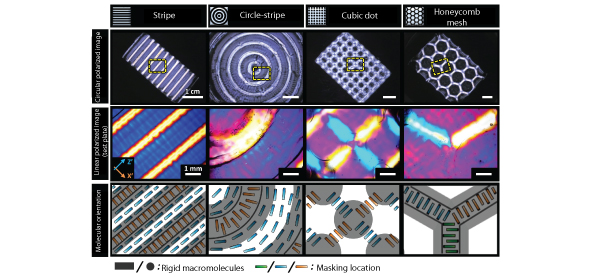Hydrogels with Cartilage-like Macroscopic Anisotropic Structure Successfully Developed
Research Press Release | September 12, 2014
-
 Mechanism to form cartilage-like structures in gels
Mechanism to form cartilage-like structures in gels -
 Various superstructures of rigid macromolecules within gels
Various superstructures of rigid macromolecules within gels
| Press Release | ||
|---|---|---|
| Key Points | ・A method to control the macro-scale orientation of rigid macromolecules in amorphous hydrogels was successfully developed.
・This method makes it possible for the first time to develop hydrogels with cartilage-like macroscopic anisotropic structure. ・Based on this work, development of biomaterials with even higher capabilities is expected. |
|
| Overview |
Hydrogels have a high affinity for living organisms due to their soft and wet characteristics, and application as biomaterials is expected. In 2003, Dr. Gong and her study group developed high-strength double network gels (DN gels), whose strength was comparable to vital cartilage. Since this development, application of gels as bio-structural materials has become more likely. However, actual bio-tissue performs various functions in addition to dynamic strength. For example, the vital cartilage simultaneously expresses low friction that ensures smooth joint movement, can withstand a strong impact, and has a high binding capacity to bone. These diverse functions are considered to be expressed by collagen’s macroscopic (mm-ordered) anisotropic structure where collagen fibers (rigid macromolecules) are horizontally oriented on the cartilage surface and vertically oriented on the bone interface. However, development of gels with various functions has conventionally been difficult due to the absence of technologies which can introduce complex macroscopic anisotropic structures into gels. In response, master’s student Riku Takahashi and other members of Gong’s group developed “a macroscopic orientation method for rigid macromolecules by controlling the stress field within gels by osmotic pressure”. In this method, the orientation of macromolecules in gels can be freely and locally controlled by simply changing the pattern of light irradiated during gel synthesis. Using this method, it has become possible to orient rigid macromolecules within hydrogels, which generally have disordered structures, as designed for the first time. As an example, a structure imitating collagen fibers within cartilage were successfully introduced into gels. According to these results, clues in the discovery of the anisotropic structure formation mechanism in living organisms, and application in the development of biomaterials with even higher capabilities are expected. |
|
| Inquiries |
Jian Ping Gong, Professor, Faculty of Advanced Life Science, Hokkaido University TEL & FAX: +81-11-706-2774 E-mail:gong@mail.sci.hokudai.ac.jp |
|
|
Japanese Link |
軟骨に類似した巨視的な異方構造を有するゲルの創製に成功 | |
| Publications | Nature Communications (2014.8) | |
